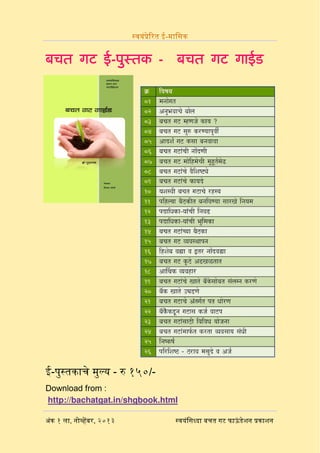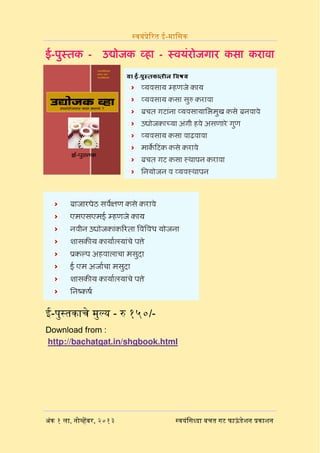November2013
- 1. ?????-? ????????? ??? ?????????? ????? ????? ?-????? ?, ? ????????? ??? ?? ???????, ???? ? www.bachatgat.in ????? ?????? ?? ??? ????????? ? ? ???? ,??????? ,?? ? ?? ?
- 2. ????? ?????? ?? ??? ????????? ? ? ???? ,??????? ,?? ? ?? ? ???????, ???? ?, ??? ? ?? ?????-? ?????????
- 3. ????? ?????? ?? ??? ????????? ? ? ???? ,??????? ,?? ? ?? ? ?????????? ??? ???????? ????? ??????? ?????-? ?????????
- 4. ????? ?????? ?? ??? ????????? ? ? ???? ,??????? ,?? ? ?? ? ??? ,?????? ?? ??? ???????? ?? ? ? ? ,?????? ??????? ? ? ??? ??????? ? ? .????? ???? ?????? ??????? ,?? ,??????? ????? ,????? ?????? ? ? ??? ?? moc.liamg@noitadnuofahddismayaws ????? ??????? ? ????? ????? ,?? ??? .??? ????? ???? ????? ???? ??????? ? ? ? ? ?? .??? ?????-? ???? ???? ?????? ??? ??? ?????-? ?? ? ? ? - .????? ???????-? ?? ????? ? ? ? .?????? ?????? ????? ?? ??? ???? ????? ????????? ????? ? ? ? ? ?? ???? ???? ?????? ?? .??? ?? ???? ?? ?????-? ?? ????? ? ? ? ? ? ? ? .??? ???? ?????? ????? ??????? ?? ,???? ??? ?????? ???? ? ? ? ? ? ????-? ???? ???? ????????? ??? ????? ?? ??? ??? ????? ? ? ? ? ? ? ????? ,??????? ?? ?? ??? .??? .????? ?????? ?????? ???? ? ? ? ?? ?????? .????? ?? ??????? ? ??? ,??? ??????? ???? ? ? ? ? ???? ????? ?????? ?? ??? ???? ????? ? ?? ?????-? ?? ? ? ? ? ? ? ? .??? ?????? ???? ???? ??? ??????? ? ? ? ? ? ?? ??? ,????? ??-??? ????? ??? .??? ???? ??? ???????? ? ? ? ? ? ??????? ??? ?? ??? ??? ,??? ,?????? ?? ??? ???????? ? ? ? ? ?? ? ? ? !! ????? ????? ????? ?????????? ??????? ?? ??? ?? ? ? ? ? ? ?????-? ????????? ???????
- 5. ????? ?????? ?? ??? ????????? ? ? http://bachatgat.in/shgbook.html ?-???????? ???? - ? ???/- ???? ,??????? ,?? ? ?? ? ????? ? ???? ????? ?? ? ? ? ???? ???????? ???? ? ?? ???????? ?????? ? ? ? ? ????? ????? ??????????? ???? ? ??? ???? ??????? ? ????? ?? ?????????? ????? ??? ? ? ? ? ????? ?? ??? ????? ? ??? ???? ????? ? ? ? ? ? ? ? ? ? ? ??? ? - ??? ??????? ????????? ?????????? ??? ????? ???? ???? ????? ??? ? ? ? ?????? ???? ? ?? ??? ??????? ? ?????? ???? ??? ? ????? ????? ??? ?? ??? ??? / ???? ???? ??? ? ? ? ? ?? ??? ????? ????? ? ?????? ,??? ???? ??? ? ? ? ??? ???? ?? ??? ? ???? ???? ??? ??????? ?????? ? ? ? ?????? ????? ??? ? ? ? ? ? ? ? ? ? ? ? ?-?? ?? ? ????????? ©»??? ??? ? - ??? ?? ??? ????? ??? ?? - ???? ????? ???????? ???? - ?-????? ?? ?????-? ?????????
- 6. ????? ?????? ?? ??? ????????? ? ? ???? ,??????? ,?? ? ?? ? ???[????? ???????? .?? ?????? ???? ? ? ? ? ? ???? ???? ?? ? ????? ???? ?? ????????? ?? ??? ???????? ? ? ? ?????? ?? .???? ??? ?????? ????? ??????? ???? ??????? ? ? ? ? ? ????? ????? .?????? ?????? ???????? ?? ??? ??????? ? ? ? ? ??? ?????? ??? ????? ?????? ?? ??? ????? ?? ????? ? ? ? ? ???? ,?????? ?? ??? ???????? ???? ????.??.?? ????? ? ?? ? ? ? ? ?????, ? ???. ?????, ???? ???? ????? ??? ?? ??????. ?????-? ????????? ????? ??????
- 7. ????? ?????? ?? ??? ????????? ? ? ???? ,??????? ,?? ? ?? ? ? .??? ??? ????? ? ? ? ??? -/???,??.? ??? ?? ?? -/???,??.? ????? ????? ? ? ? ? ? ? ? ?? ??? ??? ????? -/???,??.? ?????????????? ?????? )????? ? ? ? ? ? ? ? ?????( ,??????? ????? ?? ? ???? ????? ????? ????? ? ? ,????? ???? ????? ???????? ??? ????????? ???????? ? ? ???? ??? ?????? ??????? ?????? ??????? ????? ? ? ? ????? ?????? ???? ???? ??? ????? ????? ???????????? ? ? ? ? ? ,????? ??? ??? ???? ??? ?????? ??????? ???? ? ? ??? ?????? ????? .??? ????? ????????? ???? ?????? ????????? ????? ,????????? ? ? ? ? ????? ?????? ? ??????? ??? ???? ???? ????? ??????? ?? ? ? ? ? ? .????? ????? ??????? ? ? ???????????? ???? ???? ????????? ????? ????? ? ????? ? ??? ???? ??? ???????? ?????? ,??? ???? ????? ???? ? ? .??? ?? ??? ???? ??? ???? ????? ? ? ? ????????? ? ????? ,???? ??????? ?????? ????????? ???? ? .?? ??? ???? ??? ??????? ? ? ? /?????? ????? ??? ????-?? ??? ???? ?????? ????? ? ? ? ? ? ? .?? ??? ?????????? ? ???? ??? ????????? ???????/?????? ??-?? ???????? ? ? ? ? ? ? ? ? ? ? ??? ?? ????? ??? ? ?????-? ?????????
- 8. ????? ?????? ?? ??? ????????? ? ? ???? ???????? ??? ? ? ??????????? ???? ,??????? ,?? ? ?? ? ????? ? ? ??? .???? ??? ????????? ??? ??? ? ??? ???? ? ? ? ? ? ??? ?????? ????? ? .??? ??? ?? -/???,??.? ?? ? ? ? ???? ?????? ?????? ??????? ????? ?? .??? ??? ???????? ?? ? ? ? ? ? ????? ??? -/???,??.? ???? ??? %?? ?????????????? ? ? ? ? ? ?????? ????????? ,?????????? ? ???????????? ,????? ? ? ? ? ? ????? ?????? ???? ???? ??? ????? ????? ???????????? ? ? ? ? ? ,????? ??? ??? ???????? ??????? ?????? ??????? ???? ? ? ? ? ? ? .???? ?? ???? ??????????? ? ? ? ?????? ?? ?:? ? ?:? ??????? ??????? ?????? ??? ??????? ? ? ? ? .???? ?? ?????????? ?????? ?? ? ? ?:? ? ?:? ????? ?????? ??????? ?????? ??? ??? ?????? ? ? ? ? .?? ??????? ? ? ? %??.? ?? -/???,?? ? ???????? ??? ? -/???,?? ? ? ? ? .? ??????????? ??????? ?????? ??? ????? ?? ?? ??? ? ? ? ? .???? ?????? ?????? ??????? ??? ??.?.? ??? %?? ? ? ? ? ?? ? ????? ? ??? ??? ????? )%??( ??? ??.?.? ?????????????? ? ? ? ? ? ?????? ????????? ,?????????? ? ???????????? ,????? ? ? ? ? ? ?????-? ?????????
- 9. ????? ?????? ?? ??? ????????? ? ? ???? ,??????? ,?? ? ?? ? ? .????? ?????? ????? ??? ??? ???? ? ?? ? ??? ?????? ???????? ? ???? ????? ?? ???????? ? ????? ? ? ? ? ? .????? ???????? ????? ???? ???????? ???????? ????? ??? ????? ? ? ? ? ? ? ????? ???? ??????? ??? ???? ???? ?????? ??????? ? ? ? ? ? .???? ????? ????? ? ????? ????? ????????? ? ? ? ? ? .???? ??????? ??? ????? ?? ???? ???????? ? ? ? ? ? ? ? .???? ??? ???????? ???? ???? ????? ??? ???????? ????? ? ? ? ? ? .????? ??????? ????? ? ? .????? ???????? ????? ????? ? ??? ?????? ? ? ? ? ???????? ???? ??? ??? ????? ? ?? ?? ,??? ??????? ? ? ? ? ? ? ? ? .??? ?????? ??????? ????? ???????????? ???????? ? ? ? .??? ????? ???? ?????? ? ? ? .???? ??? ???????? ? ? ? .???? )???? ??( ? ? ? ????? ??? ?????????? ???/???,??.? ???? ?????? ? ? ? ? ? /???,?.? ????? ??? ?????? ?? ???? ??? ?????? ????? ? ? ? ? - .???? ???? ???? ?? ?????????? ???????????? ? ? ? ?????-? ?????????
- 10. ????? ?????? ?? ??? ????????? ? ? ???? ,??????? ,?? ? ?? ? ??????? : ??? ? ? ?????? ??? ??? ,??? ? ? ? ? ???? ???? ??? ??? ?? ???????? ?????? ??? ? ? ? ? ? ? ??? ??? ???????? ????????? ,?????????? ?????? ?????? ?? ? ? ? ? ? ?? ? ? ? ? ?????? ???????? .??? ???? ????? ????? ????? ????? ???? .??? ???? ????? ????? ????? ????? ???? ?? ?? ?? ?? .??? ???? ????? ????? ????? ????? ???? .????? ?????? ????? ??????? ????? ????? ?????????? ?? ?? ??? ?????? ????? ????????? ? ? ??? ???? ?????? ?? ????????? ???????? ? ? ? ? ? ??? ??????? ?????? ????? ? ? ? ??? ??????? ?????? ????????? ? ? ? ? ????? ???? ???????? ?????? ???????? ? ???? ? ? ? ? ??????? ??????? ?????? ???????? ? ? ? ?????? ???????? ???? ? .???? ???? ????? ?? ??? ??? ????? ? ? ? ? ? ? ? ? ? ? ? ? ? ? .??? ??? ???? ?? ??????? ??????? ?????? ???????? ? ? ? ? ? ? ? ? ?????? ???????? ?? .??? ?? ????? ????? ?? ?????? ? ? ? ? ?? ???? ???? ?? .??? ???? ???? ??? ????????? ????????? ? ? ? ? ? ??? ???? ?????? ?? ,??? ,?????? ?? ??? ???????? ? ? ?? ? ? ? ??? ,?????? ?? ??? ???????? ?? ? ? ? ????? ?©½??? ?????-? ?????????
- 11. ????? ?????? ?? ??? ????????? ? ? ???? ,??????? ,?? ? ?? ? ??? ???? ????????? ? ? ????? ?????? ????? ??????? ????-??????? ? ? ??? ???? ? ?????? ??????? ???????? ? ? ? ? ????? ,??????? ??? ????? ?????? ?? ??????? ?? ? ??? ???? ????? ? ? ? ? ??? ??? ?????? ? ? ? ? ???? ??????? ?? ????? ??? ????????? ????? ????????? ? ? ? ? ? ? ????? ??? ??? ?? ,??????? ??? ????? ???????? ???????? ?? ? ? ? ? ? ? ? ????) ????? ????? ?????? (????) ???? - ??? ? ? ??? ??.?? : ???? ????????? ????? ?????? ????? ?????? ????-??????? ? ? ?????? ???? ???????? ? ??? ?? ? ? ? ??? ???? ? ?????? ??????? ???????? ? ? ? ? ???? ? ???? ????? ????? ,?????? ??? ????? ?????? ??????? ????? ? ? ??? ???? ????? ? .??? ???? ?????? ??????? ????? ???????? ? ? ?? .?????? ?????? ???? ???? ?????????? ??-????? ?? ???? ? ? ? ? ? ? ? ? ? ? ? ? ? ? ????? ????? ?????? (?????) ??) ?????-? ?????????
- 12. ????? ?????? ?? ??? ????????? ? ? ???? ,??????? ,?? ? ?? ? .????? ????? ? ? ? ?????? ??? ? ???? ?????????? ??????????? ?????????? ? ? ? ? ? ? ? ? .??? ??? ?????? ????? ???????? ????? ?? ????? ?????? ? ? ? ? ? ???? ??????? ????????? ??? ????? ????????? ???????? ? ? ? ? ????????? ?? ,???? ??????? ???? ?????? ???????? ??? ? ? ? ? ? ? ?) ????????? ????? (??? ????? ??????) ???? - ??? ? ? ??? ????? ???????? ???????? ??? ??????? ?? : ??? ? ? ? ? ? ? ? ??????? ? ????? ?????????? ,????? ????? : ???? ? ? ? )??? ? ? ? ???( ???? ?? ? ?? : ??????? ???????? ? ? .??? ??? ??????? ?????? ????? ? ? ? ? ? ???? .?? ???? ????? ???????? ??? ??????? ????? ???????? ? ? ? ? ? ? ? ????? ????? ???? - ??? ? ? ??? ??.?? : ???? ????????? ????? ?????? ????? ?????????????? ? ?????? ??? ????? ???? ,???? ?? ?????? ? ? ? ,??????? ??? ??????? ,???? ?? ???? ??????? ?? ? ? ? ? ?????? ????? ? ? ????? ?? ??? ????????? ? ? ? ? ? ? ? ?????-? ?????????
- 13. ????? ?????? ?? ??? ????????? ? ? ???? ,??????? ,?? ? ?? ? ???????? : www.bachatgat.in ???? : swayamsiddhafoundation@gmail.com ??? : ??????????? / ??????????? ????? - ?????? ??????? ???, ????? ???? ? ???, ???? ??? ?, ???? ?????? ???????, ????????? ????? ??????? ? .???? ???? ????? ???? ???????? ???? ? ????? ? ? ???? ????????? ???? .??? ??? ????????? ??????? ????? ? ? ? ? ? ? ? ?????? ????? ???????? ????? ?????? ????? ???????? ? ? ? ? ? ?????? ? ???? ????????? ?? ????????? ? ? ? ? ? ??????? ???? ?????? ?????? ????? ? ? ??? ?? ????????? ???? ????? - ??????? ???? ? ? ? ? ? ? ????? ????????? ? ?????? ????? ? ? ? ? ?? ???????? ????? ? ????? ????? ? ??? ?????? ??????? ? ??? ????? ????? ? ?????? ,???? ??? ? ? ? ? ? ? ?????? ? ????? ????? ???? ?????? ??? ? ? ? ? ? ? ??? ?? ????? ??????? ???? ????? ????? ????? ? ? ? ? ??? ?? ????? ?? ???? ? ? ? ? ? ? -:????? ??? ????? ??????? ????? ?????? ????? ???????? ? ? ? ? ? ? ? ??? ????? ????????? ??? ??? ??????? ?????? ???????? ? ? ? ? ??? ???????? ????? ?? ??? ?????? ?? ? ? .???? ??? ?????? ??????? ????? ??? ???? ? ? ? ? ? ? ? ? ? ? ? ? ?????-? ?????????
- 14. ?????-? ????????? ??? ???????? ???? ????? ????? ?????? [ 1. ???? ???? 23. ©»????? 2. ???? ????? ? ????? 24. ???????? 3. ????? ??? (???? ???) ? 25. ?????? ?Ī┴???? 4. ????? ?????? 26. ?????? 5. ??? ????[ 27. ????? ?????? ? 6. ?? ?? ????? 28. ??[? ?????? ??? ??[? 7. ?? ?????? ?Ī┴????? ???, ????? ? 8. ????? ?????? 29. ??? 9. ?????? ?????? ???? 30. ?????, 10. ?????? 31. ??????? ?. 11. ???? 12. ?????? ? ??? ??? ?Ī┴?????. 13. ??? ????? 14. ???? ???? 15. ©½??????? ???? 16. ?????, ???? ? 17. ??©ż?, ????, ??? ? 18. ??????? 19. ???? ????? 20. ?? ? ?????? ????[ ? ? 21. ?????? 22. ????? ????? ?????? ?? ??? ????????? ? ? ???? ,??????? ,?? ? ?? ?
- 15. ????? ?????? ?? ??? ????????? ? ? ???? ,??????? ,?? ? ?? ? .?? ??? ???????? ????? ???? ???? ,??????? ??? ?????? ??? ?? moc.liamg@noitadnuofahddismayaws ? ? ?? ??? ??? ????? ??????? ????? ?? ???? ????? ? ? .???? ?? ?? ???? ??????? ? ???? ??????? ????? ???? ??? ??? ???????? ???? ?????? ? ? ? ? ? ???? ????????? ???? ?? ??? ?? ?????? ?? ??? ??? ?? ? .????? ??? ???? ??? ???? ???? ???????? ? ? .???? ?? ????? ??????? ?? ??????? ????????? ????? ? ? ? ,?????? ????? ?????? ?? ????? ?? .??? ?????? ?????? ? ? ? ????? ???? ???? ?? ??????? ?? ???????-? ?? ????? ???? ??? ? ? ? .??? ???? ????? ???? )???? ??? ??? ? ? ? ?? ???( ???? ???? ??? ??? ,???? ????? ?? ?? ??? ???? ? ? ? ? ? ? ? ? ? ?? ????? .? ????? ????? ,?? ????? ,??? ???? ??????? ? ? ? ? ? ? ? ? ?????? ??? ??? ??? ?? ??? ????? ????? ??? ???? .????? ? ? ? ? ?? ??????? ???? ??????? ?? ????? ???????? ?????? ??? ? ? ? ? ????? ???? ????? ?????-? ?????????
- 16. ?????-? ????????? AGARBATTI STICKS I. INTRODUCTION: The burning of incense in religious and social functions have been practiced in India since early times. Dhup an aromatic powder or paste is burnt in Indian homes as a fragrant fumigant and is reputed to posses insecticides and antiseptic properties. Agarbathi also known as Udubathis similar to jars sticks are a development of Dhup. About 75% of agarbattis manufactured are of cheap quality containing only charcoal powder or low quality sandalwood powder with a mixture of 50% of wood gum powder. Cheap perfumes are used to give them a top note. In superior variety, essential oils, purified resins, natural fixative like Amber, musk and civet are used along with synthetic aromatics. Absolutes are used in the costlier types. II. MARKET POTENTIAL Agarbathies are used by all communities in India, Sri Lanka, Burma and by Indians residing abroad. As on today about 90 foreign countries are using our agarbathis. Agarbathies industry is one of the labour intensive cottage type of traditional industries in India Karnataka state leads in this industry. The main centres of manufacture are Mysore and Bangalore. As on today about 150 units exist in Andhra Pradesh. It is export-oriented unit also. In fact this is one of the items considered for boosting exports. Owing to the low level of technology involved in this industry, this can be taken to rural areas without much difficulty, thus implementing the rural industrialization policy of the government of India to a greater extent. III. BASIS AND PRESUMPTIONS: a) The estimes are drawn for a production capacity generally considered techno-economically viable for model type of manufacturing activity. b) The information supplied is based on a standard type of manufacturing activity utilization conventional technique of production at optimum levels of performance. ????? ?????? ?? ??? ????????? ? ? ???? ,??????? ,?? ? ?? ?
- 17. ?????-? ????????? c) The cost in respect of land and building, machinery and equipment, raw materials and selling prices of the finished products etc. are those generally obtaining at the time of the preparation of the project profiles and may vary depending upon various factors. IV. IMPLEMENTATION SCHEDULE: No specific time is required to set this unit. The unit can be set up within shortest time as basically it is a cottage industry. V. TECHNICAL ASPECTS: Process of Manufacturing: All the ingredients in powder form are mixed well in the proper proportion with water to semi-solid paste. This paste is applied to bamboo sticks and rolled on wooden planks with hands uniformly. The raw sticks are then dried and packed in suitable bundles. For manufacture of perfumed agarbattis the concentrated perfume is diluted first with white oil or di-ethylphathalate (generally 1:3) and raw agarbathis are dipped and packed immediately in butter paper bags or polypropylene bags and finally in printed cartons. The composition for masala for this is as under: White Chips 40% Gigatu 20% Charcoal 20% Aromatic chemical Essential oil and other ingredients 20% The composition can be modified according to the requirements. Quality Specification There is no ISI standard for manufacture of Agarbathi at present. However, they are manufactured as per customer's requirements. Production Capacity per annum Quantity: 960000 pkts Value: Rs.2460000 Motive Power only for lighting VI. TOTAL CAPITAL INVESTMENTS ????? ?????? ?? ??? ????????? ? ? ???? ,??????? ,?? ? ?? ?
- 18. ?????-? ????????? VII. MEANS OF FINANCE 1.Promoter's Contribution (5% of total cost) 2.PMEGP subsidy (15% of total cost or Rs.7500,whichever is less) 3.Bank loan[total cost( Promoter's Contribution+ PMEGP subsidy) 22745 7500 424650 1. FIXED CAPITAL i)Land & Buildings: Rented premises of 100 sft. Rent of Rs.1000 pm ii) Machinery & Equipment ????? ?????? ?? ??? ????????? ? ? ???? ,??????? ,?? ? ?? ?
- 19. ?????-? ????????? 2. WORKING CAPITAL i) Staff & Labour per month ii) Raw Material (p.m.) iii. Utilities per month ????? ?????? ?? ??? ????????? ? ? ???? ,??????? ,?? ? ?? ?
- 20. ?????-? ????????? iv. Other expenses per month v. Total working capital per month IX COST OF PRODUCTION PER ANNUM ????? ?????? ?? ??? ????????? ? ? ???? ,??????? ,?? ? ?? ?
- 21. ?????-? ????????? X TURNOVER PER YEAR XI FIXED COST PER YEAR XII. PROFIT ANALYSIS Net Profit : sale-total cost=2400000-1840315=559685 % of Profit on Sale: Profit / Sale x100=559685/2400000] 100=23.32% % of Return on Investment: Profit / (Investment) x 100=123% Break-Even Analysis : FC / (FC+Profit) x100=123655/123655+559685]100=18.10 ????? ?????? ?? ??? ????????? ? ? ???? ,??????? ,?? ? ?? ?
- 22. ?????-? ????????? ?-?? ??? ?? ? ????? - ??? ?? ???? ?-???????? ???? - ? ???/: morf daolnwoD http://bachatgat.in/shgbook.html ????? ?????? ?? ??? ????????? ? ? ???? ,??????? ,?? ? ?? ?
- 23. ?????-? ????????? ?-????? ?? ????? ??? - ?????????? ??? ????? ?-???????? ???? - ? ???/: morf daolnwoD http://bachatgat.in/shgbook.html ????? ?????? ?? ??? ????????? ? ? ???? ,??????? ,?? ? ?? ?
- 24. ????? ?????? ?? ??? ????????? ? ? ???? ,??????? ,?? ? ?? ? ???? ?????-? ?????????


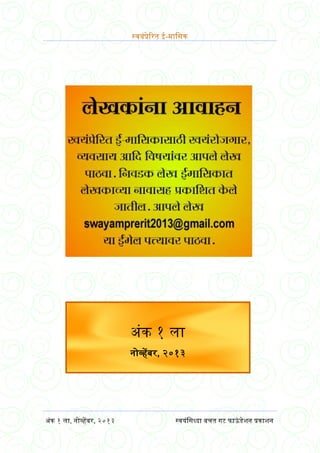

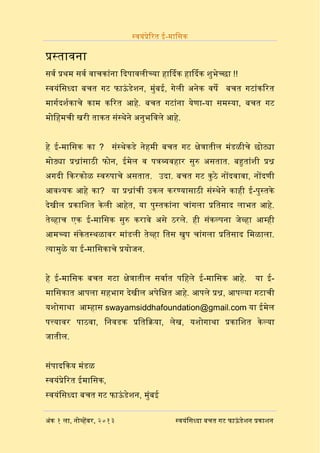
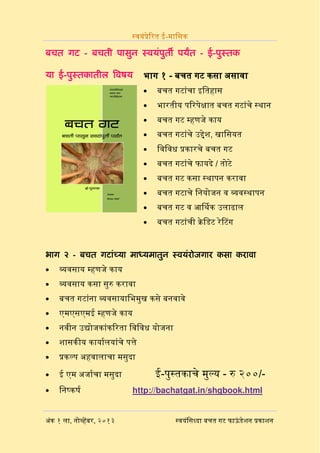
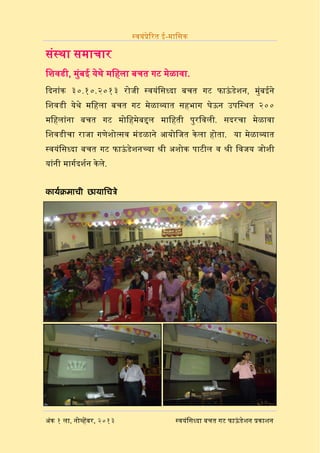
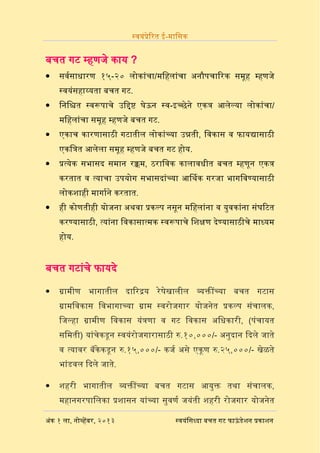
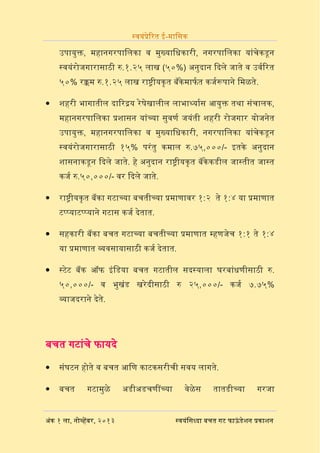
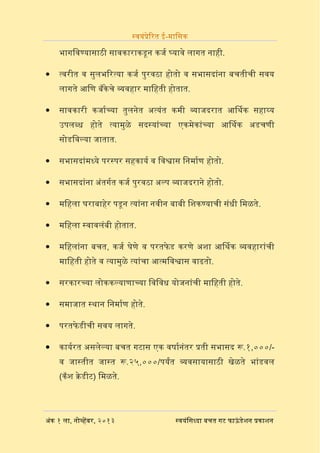

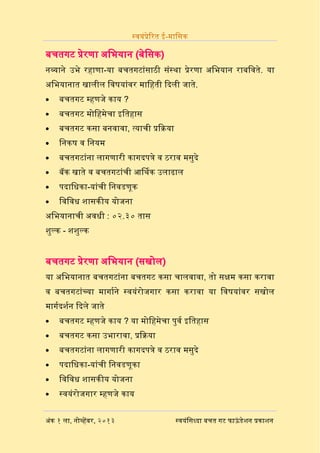
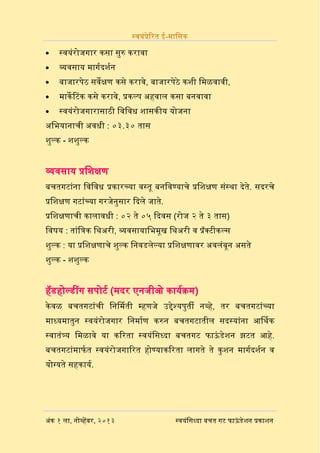
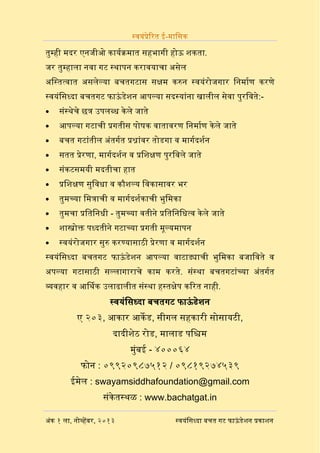
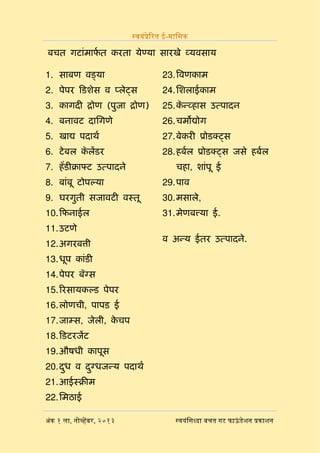
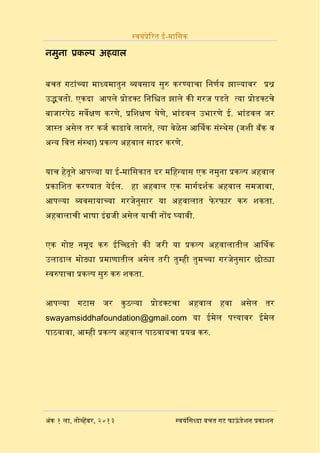
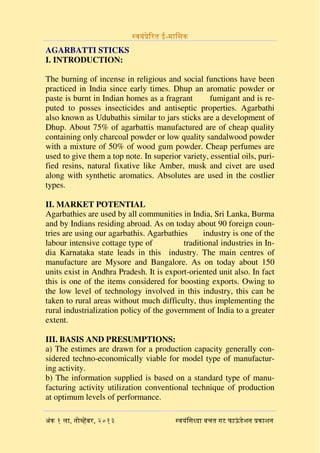




![?????-? ?????????
X TURNOVER PER YEAR
XI FIXED COST PER YEAR
XII. PROFIT ANALYSIS
Net Profit : sale-total cost=2400000-1840315=559685
% of Profit on Sale: Profit / Sale x100=559685/2400000]
100=23.32%
% of Return on Investment: Profit / (Investment) x 100=123%
Break-Even Analysis : FC / (FC+Profit)
x100=123655/123655+559685]100=18.10
????? ?????? ?? ??? ?????????
? ?
???? ,??????? ,?? ? ??
?](https://image.slidesharecdn.com/november2013-131103122345-phpapp01/85/November2013-21-320.jpg)
